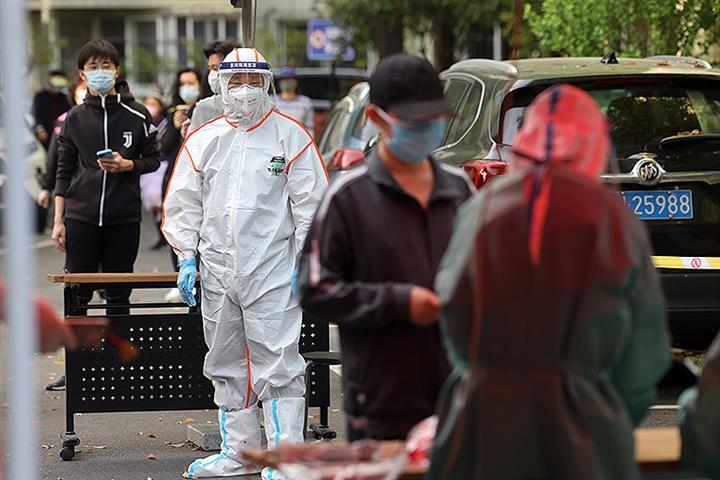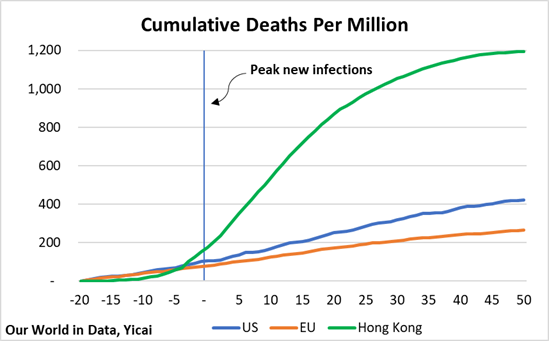 Shanghai’s Lockdown: A Cost-Benefit Analysis
Shanghai’s Lockdown: A Cost-Benefit Analysis(Yicai Global) April 28 -- They say that we will be allowed out of our apartments on April 29. That will make it more than a month that we have been confined to our homes.
Residents of other buildings in our compound are already allowed to move around the grounds. In April, the weather in Shanghai is lovely and they have been taking advantage of our small gardens.
Our building continues to be locked down because, until April 16, some of my neighbours kept testing positive. We think the infections come on the surfaces of parcels. Or that we transmitted the virus to each other when we stood in line for our Covid tests.
To minimize the risk of becoming infected, my neighbours use the elevator sparingly. Moreover, they text the building’s WeChat group to announce they will descend to throw out garbage or pick up deliveries. They text again when they have returned to their apartments, indicating the elevator is now free.
When we go to be tested, many of my neighbours wrap themselves up in rain slickers – as if they are expecting a downpour – which they disinfect when they return home.
It is easier to get food delivered now. My wife found a bottle of my favourite scotch at a reasonable price and a neighbour gave us a couple of jars of the chili sauce that makes everything taste better (老干妈). Nevertheless, the strain of being locked in for so long is beginning to show. Increasingly, our neighbours vent their frustrations in our WeChat group.
As of April 26, Shanghai recorded just 238 Covid-related deaths. Some people take this low figure as a sign that the lockdown is not saving many lives and is not really necessary. Meanwhile, the foreign press accuses the authorities of “” the true death toll.
There will always be some uncertainty about what constitutes a death from Covid: whether the virus was the direct cause of death or just a contributing factor. This has led to an analysis of “excess mortality” as a more reliable alternative. Shanghai publishes its death data annually, so we will be able to see if the number of people who died this year was abnormally high. In the meantime, I would like to present some counter-factual scenarios to show that Shanghai’s lockdown truly is saving lives.
I want to compare the current Omicron outbreak in Shanghai to those that occurred in the US, the EU and Hong Kong earlier this year (Figure 1). To do so, I will define each outbreak’s starting point as 20 days before new cases peaked. Using this timing convention, Shanghai’s outbreak has lasted for 32 days, 12 days past the peak (to April 26).
Figure 1

For each episode, we can decompose the death rate – the number of deaths per million people – as the product of the infections per million people and the share of infections that resulted in death.
The death rates and their components for the outbreaks in the EU, the US and Hong Kong, over the first 32 days of each episode, are presented in Table 1. In comparing the EU and the US, note that the infection rate was higher in the former and the death-per-infection ratio was higher in the latter. Hong Kong was very high on both counts.
I can calculate naïve death tolls for Shanghai (which I call Scenario 1) by multiplying its population of 25 million by each of the three death rates.
Table 1:
Estimated Shanghai Deaths Given EU, US and HK Death Rates

While there may be some uncertainty about the Covid-related death rate in Shanghai, I think we can have a lot more confidence in the reported number of infections. I have been tested dozens of times in the past month as part of an effort to identify and isolate infected people and Shanghai’s public health officials rely on the infection data in their decision making.
Over the past 32 days, there has been a total of 537,667 infections in Shanghai, or 21,507 per million people. This is a considerably lower infection rate than was recorded in the US, the EU or Hong Kong over the first 32 days of those outbreaks (Figure 2).
Figure 2

I now construct a second scenario by multiplying Shanghai’s actual infection rate by the death-per-infection rates observed in the EU, the US and Hong Kong (Table 2). We can call the difference between the Scenario 2 and the Scenario1 deaths a measure of the lives saved by Shanghai’s “Zero Covid” approach. Thus, even if one did not believe the official deaths data, they would still have to conclude that Shanghai’s lower infection rate must have resulted in a significant number of lives saved.
Table 2:
Estimated Shanghai Deaths Given Actual Infections and EU, US, HK Infection-Fatality Ratios

Shanghai’s “Zero Covid” policy also had public health benefits that extended well beyond the city’s borders. As was the case with Wuhan’s outbreak in late 2019, the authorities have been fairly successful in preventing the virus from spreading around the country.
To quantify this benefit, I want to look at the death rates of the other episodes beyond their first 32 days, since none of them were fully under control in such a short period. Figure 3 presents the death rates for the three episodes from 20 days before to 50 days after their peaks. Using the terminal death rates and China’s population of 1.4 billion, I calculate that the country avoided incurring between 381,562 and 1,723,955 additional deaths by preventing the outbreak’s spread to the entire country.
Figure 3

While Shanghai’s “Zero Covid” policy has saved a huge number of lives, it has also been very costly.
To estimate these costs, I rely on work done by a team of academics from universities in China, the US and Hong Kong. Using truck flow data, they that locking down a city like Shanghai for one month would reduce that city’s GDP by 61 percent. Last year, Shanghai’s GDP was CNY 4,321 billion. A 61 percent reduction in one month’s GDP works out to CNY 220 billion.
The academics also estimate that locking down China’s four biggest cities for a month would reduce the country’s monthly GDP by 8.6 percent. Given Shanghai’s share of the top four’s GDP, I assume that locking the one city down would reduce China’s monthly GDP by 2.6 percent, or some CNY 236 billion.
In sum, the cost of locking down Shanghai for one month implied by the academics’ work is CNY 456 billion (0.4 percent of GDP). This is very close to my estimate, based on mobility data, which suggest that growth in April will fall from a baseline 5.5 percent to between 0-1 percent.
Armed with this cost estimate, I can calculate the per-life-saved cost of China’s public health measures (Table 3). Depending on the counter-factual death rate assumed, the cost would work out to between CNY 260,000 and CNY 1,200,000 per life saved.
Table 3:
Cost of Lives Saved in China Assuming Total Cost of CNY 456 Billion

Could the same result have been achieved more cheaply?
Given Shanghai’s starting point, I don’t think so. The problem was that when the outbreak occurred, many Shanghainese were vulnerable. To some extent, Shanghai was a victim of its own success. The very low risk of becoming infected – there were very few cases in the last two years – led to a sub-optimal rate of vaccinations.
Take my family as an example. My wife and I each received two vaccinations. My 10-year-old only had one and we never got around to vaccinating my 5-year-old. My parents-in-law, who are in their 60s, have not been vaccinated and neither has my grandfather-in-law, who is a healthy 95-year-old. I do not think our situation is atypical.
In retrospect, Shanghai could have learned something from the experience of Montreal, my hometown. My 88-year-old mother got her fourth shot this month. She got her first in March 2021, when the elderly were prioritized in Montreal’s vaccine rollout. Moreover, my Mom had to show her “vaccination passport” to enter public places like restaurants. This incentivized people to get their shots.
If Shanghai could turn the clock back, a more aggressive vaccination campaign would have meant fewer vulnerable individuals. This would have made it possible to save lives at a reduced cost.